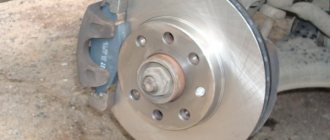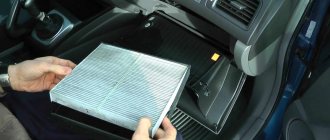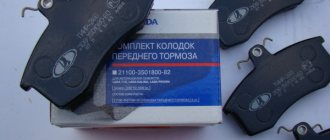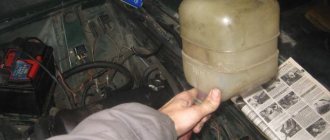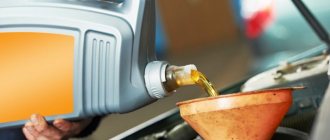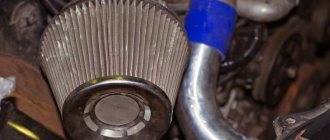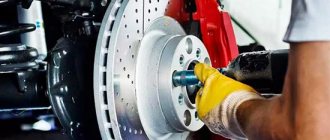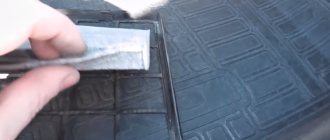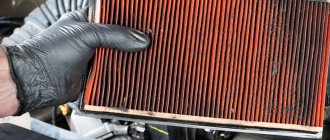While some drivers almost never use some car functions (the parking lights in BMW (Parking Lamps) are a prime example), the brakes are used constantly on any car. At the same time, they are sometimes deprived of attention.
Yes, yes, almost every motorist knows that the pads need to be changed periodically and the brake fluid level must be checked occasionally. How often should brake discs be changed?
In fact, few will give a concrete answer to this question. Wear greatly depends on operating conditions. Car manuals may not indicate the frequency of replacement at all, but at the same time instruct technicians to check their condition during each maintenance. With gentle use, the discs can travel more than 120 thousand kilometers, and in inept... legs they will require attention after 30 thousand.
Support discs, like pads, are consumables. The front ones especially, because they bear the lion's share of the load when slowing down and stopping the car.
Important: how quickly a brake disc wears down is influenced not only by operating conditions, but also by the choice of pads. The composition of the friction lining, which is in contact with the surface of the disc, varies. You may come across an aggressive version that literally eats metal and at the same time does not stand out in any way by improving tenacity.
Cast iron brake discs
The use of cast iron is widespread for the manufacture of brake discs. During braking, the friction temperature increases.
The design of the brake disc is shaped like a flying saucer to dissipate heat.
- Cast iron is a certain metal alloy with the addition of carbon to give it hardness, which has excellent frictional properties.
- The negative side of using cast iron is the change in hardness with a sharp increase in temperature.
What does it depend on?
Front brake disc wear depends on various reasons. Each factor reduces the “lifespan” of a part to varying degrees.
What does it depend on:
Conditions in which the vehicle is used. Discs are subject to severe wear if the driver regularly drives along mountain trails or “killed” roads. This is due to “frequent braking.”
A vehicle equipped with a manual transmission can be slowed down by the “engine”. It turns out that the pads and discs of such cars wear out longer. In cars with automatic transmission, braking occurs only due to the brake system, so its parts wear out faster.
The rate of wear is affected by the type of discs and wear resistance class. There are many types of discs, but the most “low-quality” ones are solid ones. Wear resistance depends on the cost and type of disc. Sometimes the manufacturer specifies the mileage that the disc will withstand.
The “lifespan” of the disc is noticeably reduced if the driver practices extreme driving. This driving style involves fast acceleration and sudden stops.
Pad hardness is another factor that affects wear. If they are soft, the disk life will increase and braking will be soft. A hard pad wears out the disc a lot, making the “stop” abrupt and rough.
Disc wear also depends on the make of the car. For example, SUVs are equipped with large wheels. To stop such a “beast”, it is necessary to equip it with a reinforced braking system. If the machine is additionally loaded with cargo, then abrasion will occur faster.
The service life of disks is directly proportional to its quality. Low-quality parts are made from cheap material and, accordingly, wear out faster. Over time, they acquire external defects, which negatively affects the operation of the braking system. It turns out that better quality metal will last longer.
Wear occurs faster if the car has other faults. For example, in the case when the car has problems with the cylinders or is filled with low-grade brake fluid. As for the anti-lock braking system, on the contrary, it extends the life of both pads and discs, as it works in accordance with force optimization.
Carbon brake discs
Such discs weigh much less than cast iron. Have a higher coefficient of friction. They function effectively only at very high temperatures. Therefore, they are widely used in extreme, sports driving.
An option for widespread use is world-class auto racing championships. The only drawback of such discs is their high cost.
Questions and answers
What is the service life of discs and pads?
There are a large number of factors that influence the service life of parts. Many manufacturers believe that the lifespan of pads is 30-120 thousand kilometers, and that of discs is 3-4 times longer. On domestic cars, parts must be replaced after 10 thousand km, and on foreign cars after 20 thousand km.
What is the cost of brake discs?
The average price of discs ranges from 3,000 to 5,000 rubles per unit. The highest quality parts with the best characteristics cost about 7,000 rubles or more.
Is it possible to drive with worn rims?
The rotors help the driver stop the car. If they do not work correctly or are worn out, it means that the car owner will not be able to brake, especially in the event of an emergency. This will lead to dire consequences. That is why, when problems are detected, it is better to eliminate them immediately, and not endanger pedestrians and other drivers.
Ceramic brake discs
They have high resistance to elevated temperatures. It is highly resistant to corrosion and wear. Has high durability.
- There are negative sides - as the temperature drops, the friction coefficient decreases, which slows down the braking process.
- When braking, they create a terribly unpleasant grinding noise.
- Ceramic discs are the future. The cost is prohibitively high.
Is it possible to fix the defect?
After conducting a “study” of disc wear, the driver begins to think about restoring the part. In most cases, the disk requires replacement. It can be sharpened, but only if there is a residual thickness of 22 mm or more. This applies to ventilated types. All other types of disks must be replaced. As a last resort, you can restore it if it is temporarily impossible to purchase a new part.
Using certain equipment, gouges and beads can be removed. Drivers sometimes use a file in their work. A thin layer is scraped off both sides of the disc to obtain a smooth surface. The more the layer is cleaned, the shorter the disk’s service life will become. In “advanced” cases, you have to remove several layers.
Before installation, it is better to check the product again for reliability. It is not recommended to grind a disc that is worn unevenly. Before the procedure, runout and wear are measured, and only then a decision is made about grinding. On machines you can sharpen the disc to a tolerance of 0.005 mm.
Wear limit
Every car enthusiast must know the permissible wear limit for brake discs on his car. Many drivers use their cars to the limit. When listening to the squeak of friction of the pads on the brake disc.
Only then do some drivers think about a replacement. When using the braking system at maximum limits, an emergency situation on the road is created. The manufacturer himself sets the maximum permissible standards.
Displaying markings using one of two methods.
- Inscription on the rim of the disc
- Mark on the recess at the end of the disk on its inner side.
The standard size of brake disc thickness can be measured with a caliper. Not every driver has such a measuring device. You can check the thickness of the brake disc with your own finger.
Every brand of car has its own permissible wear limit. The reasons for increased wear depend on the vehicle's engine. In winter, the requirements for braking properties increase. Reducing the thickness of the disk by two to three millimeters from the nominal dimensions is no longer acceptable.
Wear occurs as a result of friction between brake pads and discs lubricated with a friction compound. Wear is affected by the functioning of the entire brake system, the technical operating conditions of the car, and even the driving style.
The operation of the system is affected by the seasonality of the weather, the interaction of soil and sand and moisture, and the poor condition of the road surface.
Brake system maintenance
To keep your car safe and not cause an accident, it is necessary to regularly service the brake system. It involves regularly carrying out a certain set of works aimed at identifying the degree of wear of parts and replacing them if they reach a critical value. The maintenance process consists of the following operations:
- Check the thickness of the brake pads and replace if insufficient.
- Diagnostics of the condition and functioning of brake cylinders.
- Check the functionality of the brake mechanism in the front and rear wheels, since in addition to rubbing parts there are springs, guides and other parts. Springs that have rotted over time often break, which increases the accident rate.
- Examination of the hydraulic system for fluid leaks.
- Determining the condition of the working cylinders and pistons; all cuffs must be intact, since fine dust often causes jamming and complete inoperability of the brake system.
How to check brake pads without removing the wheel
There are several ways to diagnose the condition of the brake disc-pad pair. One of them is the method of determining the output by the free travel of the brake pedal, but with the correct adjustment of the master cylinder pusher. Before it, the free play should be 1.2-2 mm or up to 8 mm on the pedal. In pneumatic brake drives, the free play is up to 22 mm and is regulated by a rod.
If the adjustments are normal, then when you press the brake pedal, braking should occur at the very beginning. If it is observed in the middle, then the wear is equal to 50% of the permissible value, at the bottom - a critical condition. It's time to change the pads, discs or drums, unless, of course, the system is depressurized and air does not get into it.
Without removing the wheels, the thickness of the pads can be measured. To do this, it is enough to turn it to a position where you can see the pads through the holes in the wheel rim. The thickness of the brake pads depends on the specific manufacturer and the type of material used for its manufacture. The block has a multilayer device and consists of the following elements:
- metal frame;
- there is an anti-corrosion and anti-noise coating on the back side;
- on the inside there is an adhesive and sublayer;
- The working material is friction material, the thickness of which can be up to 12 mm.
The pads are considered worn out if the amount of abrasion is 2 mm, that is, 4.5%.
When to change brake pads
The maximum wear of brake pads depends on several factors. First of all, the hardness of the friction material with which they are pressed against the discs. Manufacturers offer at least two options for spare parts depending on this characteristic:
- soft;
- medium hard;
- solid.
If you want to change brake discs and drums less often, it is better to buy pads with soft linings. They will serve as part of the brake system for 10-15 thousand kilometers. It is extremely rare that the service life reaches 20-25 thousand km. On drum brakes, the pads last an order of magnitude longer because they are larger in size. The average service life is 100-120 thousand kilometers. In this case, the minimum thickness of the brake pads is determined based on its maximum. On domestic cars it can be 6 mm, but with a smaller value such parts are already dangerous and require mandatory replacement. The maximum wear of the pads is 1-1.5% of the initial condition.
When is it time to change brake discs according to maintenance regulations?
Each car manufacturer specifies exact regulations for servicing the brake system. It includes:
- determining the amount of wear by measuring the thickness of the pads and discs;
- checking the correct and synchronized operation of the brakes on each wheel;
- topping up brake fluid;
- checking rubber boots and their performance.
Reasons for replacement
You can't joke with the brakes. The main reasons affecting the functions of the car brake:
- Vibration. A property that is immediately noticeable. When the car brakes, a clearly noticeable vibration motion is felt. Indicator: deformation of brake discs. Their urgent replacement is necessary;
- Wear. An invisible property of the braking system. At the last stage of the maximum permissible wear, a metallic creak is heard;
- Corrosion. Brake discs are made of cast iron. When it gets wet, rust immediately appears, it goes away quickly on the first trip. As the car moves further, the disc becomes deformed;
- Overheating and mechanical damage reduce the effectiveness of the brake.
When to change pads?
We know how to determine the permissible wear of brake discs. But it’s worth paying attention to the pads, since these elements work in pairs and together affect braking efficiency.
One of the signs of pad wear is a squeaking sound when the speed is reduced. The sound is produced by a special wear sensor. This is a special plate. When the friction layer of the pad is worn away, the plate touches the disc and causes the sensor to operate.
If the car does not have a wear sensor, then the pads should be replaced when the thickness of the friction layer is one and a half millimeters.
You can determine that the pads are worn out by the operation of the brake system. Brakes that are too weak or too harsh can indicate wear. In the first case, the braking is not intense, although the pedal is pressed quite deeply. In the second, the wheels are blocked due to the lack of friction lining.
How to determine the wear of brake discs and pads? This can be determined by vibrations during braking, as well as by visual inspection and a measuring tool. There are no other options.
Uneven brake disc wear
There is no exact time for changing brake discs. You need to focus only on their external condition. Almost brake discs become unusable at the same time. In some cases, wear does not occur simultaneously.
There are exceptional cases when only one part can be replaced:
- Poor quality material. Especially cheap brake discs, most often they are made from not very high-quality material;
- If installed incorrectly, there is a misalignment, which leads to uneven wear of the disks;
- Damaged protective boots do not perform the protective function. Dirt may get into the brake caliper. The uniformity of friction is disrupted;
- Incorrect installation of the pads will also lead to uneven load;
- Corrosion. If the car has been standing for a long time, experiencing precipitation. Under the influence of humidity and temperature changes, the disc becomes covered with rust naturally and unevenly. The brake system wears unevenly;
- Uneven wear is caused by severe overheating of the rotor;
- Over-tightening the lever nuts can also lead to uneven, one-sided wear.
A suspicious knocking noise when you suddenly slow down will tell you that there is a distorted disk in the car. It is not recommended to grind an unevenly worn disc. When replacing discs, it is imperative to replace a set of brake pads.
Experienced car enthusiasts prefer to change front discs approximately every sixty thousand kilometers. Professional opinions differ. Some people disagree with this.
The surest way is to be guided by mileage. Even if you operate your car in a quiet, calm manner, the brake discs become unusable. Mandatory requirement for replacement immediately if any of the listed changes are detected.
What to do is strictly prohibited
Some car enthusiasts, in order to save money, practice installing linings on discs to restore their original (factory) thickness. This cannot be done, since the fixation density is insufficient and the pad will rotate.
Ultimately, this will lead to the caliper jamming, wheel blocking, and circuit breakage. At medium and high speeds, an accident is possible.
Photo instructions for replacing brake discs
What you should not do under any circumstances
It is clear that wheels are not cheap, the price can range from 1,500 to 10,000 rubles per piece, it all depends on the model and class of the car.
Some “homemade” ones solder (screw) additional linings onto the brake pads, thus giving them greater thickness. The caliper cylinder does not extend a long distance, pushing the pad, effectively as if restored! But guys, you shouldn't do this:
Firstly, there is no guarantee that this homemade cover will not come off.
Secondly, the disk is still thin, and therefore it can collapse at any moment. Watch this video here.
Remember the brakes, especially the front ones, are for your safety; you shouldn’t joke with them.
That's all, read our AUTOBLOG.
(
8 votes, average: 5.00 out of 5)
Similar news
Engine cylinder deactivation system. All the truth.
Check Engine. What does it mean and why does it light up?
Why does the turbine drive oil? To the intercooler (also to the intake manifold)

